Steel monsters: super heavy tanks of France
Super heavy tanks called tanks, weight and size characteristics of which go beyond those adopted for heavy tanks. Typically, such combat vehicles include samples that are distinguished by their enormous size and large mass (more than 80 tons). The idea of creating a super-heavy tank is an attempt to develop an invulnerable tank, which could be used to overcome the enemy’s heavily fortified defensive lines without concomitant heavy losses in equipment. Work on the creation of such steel monsters was rather active in many countries that had developed tank building and armored forces (in particular, in Great Britain, France, Germany, and the USSR). However, in the overwhelming majority of cases, these projects were not materially embodied, remaining only “paper” developments. At the same time, in France at the very end of the First World War, the super-heavy breakthrough tank Char 2C was created, which even managed to be launched into small-scale production.
Char 2C
Tank Char 2C (in some sources it is designated as FCM 2C) is the super heavy tank created in France. Its development was made in the years of the First World War, but the tank did not take part in hostilities. Char 2C has become the largest metric size among all tanks that have ever been put into service and the second largest ever built in the metal, second only to the Russian "Tsar Tank" on a wheeled chassis.
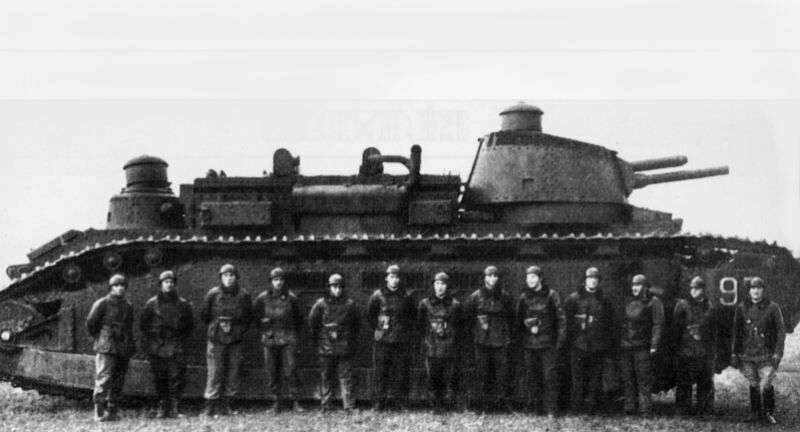
The tank was created to break through heavily fortified lines of defense in a positional war and a stable front line. He was in service with the French army until the beginning of the Second World War, however, like the Soviet heavy tank T-35 close to him, by this time it was hopelessly outdated technically and morally. Despite this, the existence of such a “land battleship” in the arsenal of the French army for almost 20 years pushed many states to develop their own super-heavy tanks.
In a way, the Char 2C was, of course, a unique fighting vehicle. History This tank began in 1916, when the General Staff of the French Army issued a task to develop a heavy breakthrough tank, which was supposed to replace the support tanks Schneider CA.1 and St.Chamond M1916, from which the French military was not enthusiastic at the time of their appearance . When developing the new tank, the French took into account the experience of the British, who created the “diamond-shaped” tanks Mk.I and Mk.II. Having considered the received projects of tanks, the most promising project was recognized by the company FCM.
The main armament of the tank was 75-mm gun ARX 1897, which was located in the turret with a sector of fire in 320 degrees. The additional armament of the combat vehicle consisted of four Hotchkiss 8-mm machine guns, one of which was located in the aft turret, two on the sides of the hull (under the main turret) and another one in the front of the tank hull. There was also a reservation that could withstand the 77-mm German field gun 7.7 cm FK 16, which was the most common 45-mm German field gun during the First World War. The front hull sheet had a thickness of 30 mm, side sheets - 35 mm. There is no exact information on the reservation of the gun turret, however, it is usually stated that it was protected by 1930-mm armor. In general, such a booking of a tank was more than adequate by the standards of that war. Moreover, up to the 2-ies it could protect the tank from any anti-tank artillery. Even by the beginning of the Second World War, the Char 35C tank was still not very vulnerable to shells fired from the main Wehrmacht anti-tank cannon, the Pak 36 / XNUMX.
The layout of this tank was hard to attribute to successful. In front of the corps there was a command compartment, the combat compartment was located behind it (the gun turret was designed for 4-s), then the engine-transmission compartment was located, and the entire aft combat compartment was completed. In order to set the car in motion with a weight of 70 tons, it took a dual engine - two carburetor «Mercedes» GIIIa hp 180 with power. each. The power plant was almost exactly in the center of the tank hull, but because of its size and the installation of additional equipment, the exhaust system and the radio station had to be carried away by the designers, closing the armored casing. It was this casing that “ate” the missing 40 degrees from the circular sector of shelling of the main gun turret.
The transmission of the tank was also difficult. Each of the engines actuated a separate DC generator, after which they applied energy to an electric motor, which actuated the corresponding track of the combat vehicle. In the event of the failure of one of the engines, the power of the electric motors was switched to one generator, after which a tank weighing more than 70 tons could move only at the speed of a pedestrian.
The undercarriage of the tank was made by analogy with the British: it had many rollers, and the tracks fully embraced the body of the combat vehicle. The diamond shape of the hull made it easier to overcome the moats and ramparts. 36 track rollers, 5 rails and 3 rollers were supported per side. The front wheels were leading, the rear - guides. The presence of a spring suspension provided the giant with a rather smooth ride, unlike English tanks with a rigid suspension. The permeability of the combat vehicle was impressive even by modern standards. Due to its long length, the tank could easily overcome ditches up to 4 meters wide, climb a vertical wall up to 1,2 meters in height and ford water obstacles to a depth of 1,6 meters. At the same time, a large mass allowed the tank to easily crush the enemy’s engineering obstacles and trees.
On the battlefields of the First World War, the tank was late, and after its completion the need for it disappeared. The initial order from 700 tanks was quickly cut down to just 10 combat vehicles. This was done for financial reasons. One FT-17 light tank cost 100 thousand francs, while Char 2C cost the budget of a war-ravaged country at 2 a million francs in 1920 prices of the year. In addition, this heavy tank was very difficult to operate and “voracious”. On average, the power plant consumed 12,8 liters of fuel per kilometer. So the huge 1280-liter fuel tank was barely enough for 100 km of traffic on the highway, while driving on rough terrain the power reserve was even smaller. Considerable money needed to be spent on car maintenance and crew training. As a result, after the release of the 10 tank, which was surrendered only in the 1922 year (after the war ended, there was nowhere to rush), the production of additional Char 2C tanks was simply abandoned. Due to its small number, each of the tanks got its own name, which made him even closer to the warship.
The tanks were quietly exploited during the interwar period and, until the 1938 year, they were used to conduct various kinds of maneuvers; in the army, they were still assigned the role of breakthrough vehicles. With the outbreak of hostilities in France in 1940, the battalion of these tanks, which were already obsolete, was sent to the theater of hostilities. 15 May 1940, a train with tanks Char 2C was blocked in the Meuse in 40 kilometers from Nofshato. There were a lot of trains at the station, while the train with fuel was ahead, the engine drivers and locomotive mechanics ran, damaging the rolling stock. Under these conditions, not being able to unload heavy vehicles from platforms, the crews of tanks destroyed the vehicles and retreated by vehicles. In this case, not all the tanks were destroyed, the Germans later captured Char 2C with the number # 99, which was not completely incapacitated. Apparently, the French were in too much of a hurry and injured only some of the components and assemblies of the tank, which the Germans then transported to Germany and even showed in Berlin at an exhibition of captured weapons. Thus, the tank, which was late for the First World War, could not even make war during World War II, remembering mainly for its size.
Performance characteristics Char 2C:
Overall dimensions: body length - 10 270 mm, body width - 3000 mm, height - 4090 mm.
Combat weight - 70-74 tons
Reservations: hull forehead - 45 mm, board - 30 mm, feed - 25 mm, bottom - 15-18 mm, roof - 10 mm.
Armament - 75-mm gun and 4 x 8-mm machine gun.
The power plant - two carburetor engine Mercedes GIIIa horsepower 2х180 hp
Maximum speed - 15 km / h (on the highway).
Power reserve - up to 150 km.
Crew - 13 man
FCM F1
At the beginning of the 1930-s, it became clear to the French military that the FCM 2C tank was hopelessly outdated. At the same time, the French military thought still believed that the new war would also be of a positional nature, like the First World War, which means that the need for super heavy breakthrough tanks still exists. The competition to create a new car was announced in November 1936 of the year. Initially, the task envisaged the creation of a tank with a mass of “all” 45 tons, but with armor capable of withstanding shelling from 75-mm guns from a distance of 200 meters. By February 1938, when the first sketches of future tanks appeared (their projects were offered by 3 firms), it became obvious that it was impossible to squeeze the characteristics required in TTX into 45 tons, therefore the mass of the combat vehicle was not specified in the new specification. This allowed the French engineers from FCM to turn around to the fullest, having designed a tank that rose on a par with the German Mouse, which was not even in the project yet.
The main task for the projected steel monster was to be the fight against the German fortifications of the West Wall (Siegfried Line), located on the French-German border. In some ways, the new designation FCM F1 was similar to the Soviet heavy tanks T-100 and the QMS, but French engineers were able to add a zest to the project. At F1, they planned to install two towers, the guns in which were to have different specializations and fight different goals, but the French chose an unusual layout for their combat vehicle. In front of the hull of the tank housed the control compartment, behind which was installed a small tower with a 47-mm gun. The engine and transmission compartment was located in the middle part of the hull, the main turret with the 90-mm gun and the fighting compartment were located in the stern. If the project were implemented in practice, the reservation of the tank would have surpassed all the machines existing at that time: frontal armor - 120 mm, hull sides - 100 mm.
The chassis tank FCM F1 was normal for the French school of tank design. As on the B1 heavy tank, a large number of track rollers were kept in it, and the design of the tracks remained almost unchanged, although the tracks became wider in order to withstand the heavily grown weight of the tank. Already at the early design stage, it was decided to abandon the originally planned 75-mm gun in favor of a more powerful 90-mm gun, and the option of using the 105-mm gun was also considered. The additional machine-gun armament of the tank was located as follows: in the small turret on the left side of the gun, on both sides of the main turret and in the stern of the main turret with an offset to the left side, the entire 4 machine gun.
Already at the design stage, the weight of the combat vehicle grew to 140 tons. In order to move such a mass of steel onto the tank, they decided to put two engines, stopping the choice on Renault 550-powered diesel engines, which paired with an electric transmission. But even the powerplant in the 1100 hp for such a mass was clearly not enough, and the estimated speed of movement on the highway would hardly exceed 24 km / h.
At the design stage of this super-heavy tank, there were many opponents in the General Staff. Part of the French officers rightly believed that the construction of such two-turreted tanks, albeit with an unprecedented 120-mm armor, takes resources and time that could be spent on the production of more useful B1bis tanks. Yes, and the combat value of FCM F1 was seen by many as highly questionable. Taking into account the ratio of the length of the tank to its width, which was approximately equal to 3,5: 1, its driving performance would be at the level of the Soviet five-towed T-35. And because of the huge mass, the movement of this mastodon through marshy or soft soil was not possible, and not every bridge could withstand an 140-ton tank.
Despite all these reasonable doubts, the FCM F1 tank was approved by the technical commission and a preliminary order was issued to FCM for the construction of 12 of such vehicles. The first tank was to be assembled in May 1941 of the year, after which it was planned to launch the production of super-heavy tanks with a machine 3-4 pace per month. In addition, the French military put forward a condition to increase on-board booking to 120-mm, which would increase the mass of the combat vehicle by another 5 tons, and the speed of movement on the highway would fall to 20 km / h. As you might guess, the Second World War and the rapid defeat of the French army left this project unfulfilled. Work on the design of this combat vehicle was stopped in the middle of June 1940, and all the blanks available for the project were apparently destroyed.
Performance specifications FCM F1:
Overall dimensions: length - 10 530 mm, width - 3100 mm, height - 4210 mm.
Combat weight - 140-145 tons.
Reservations: body shell - 120 mm, board - 100-120 mm.
Armament: one 90-mm cannon, one 47-mm cannon and 4 x 7,5-mm machine gun.
The power plant - two engines Renault V12 KGM power 2x550 hp
The maximum speed is 20-24 km / h.
Power reserve - up to 100 km (on the highway).
Crew - to 12 people.
Information sources:
http://www.aviarmor.net/tww2/tanks/france/fcm2c.htm
http://www.aviarmor.net/tww2/tanks/france/fcm_f1.htm
http://alternathistory.com/maus-po-frantsuzski-ili-sverkhtyazhelyi-tank-proryva-fcm-f1?mini=calendar%252F2015-10
http://warspot.ru/1223-sverhtyazhyolye-tanki-stalnye-velikany
Open source materials
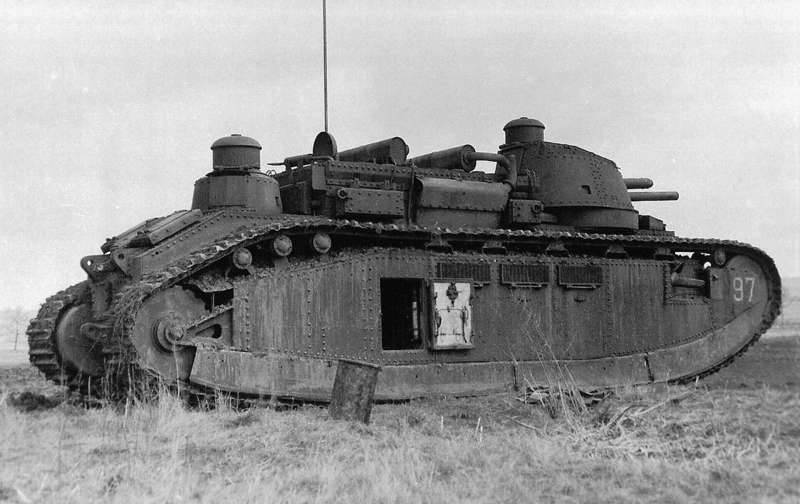
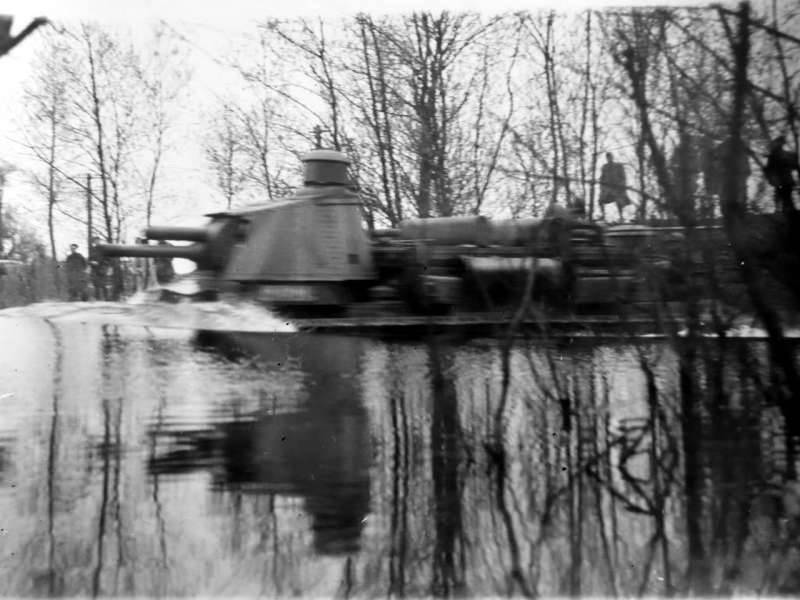
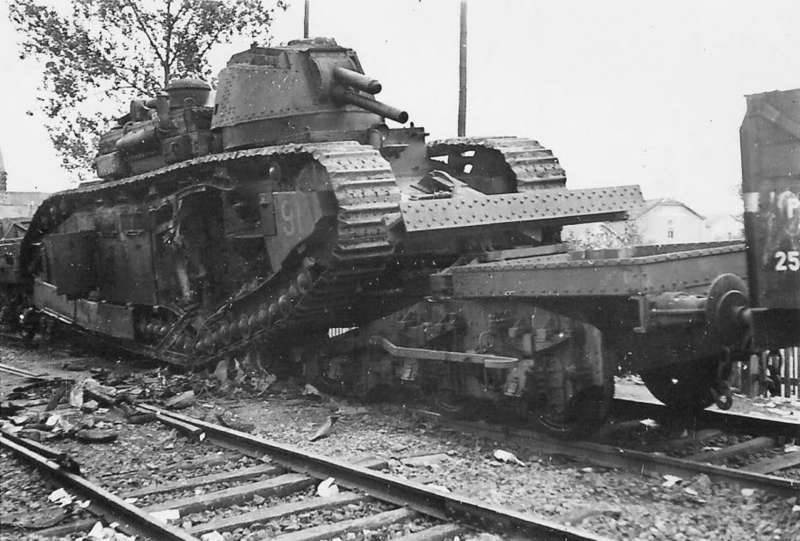
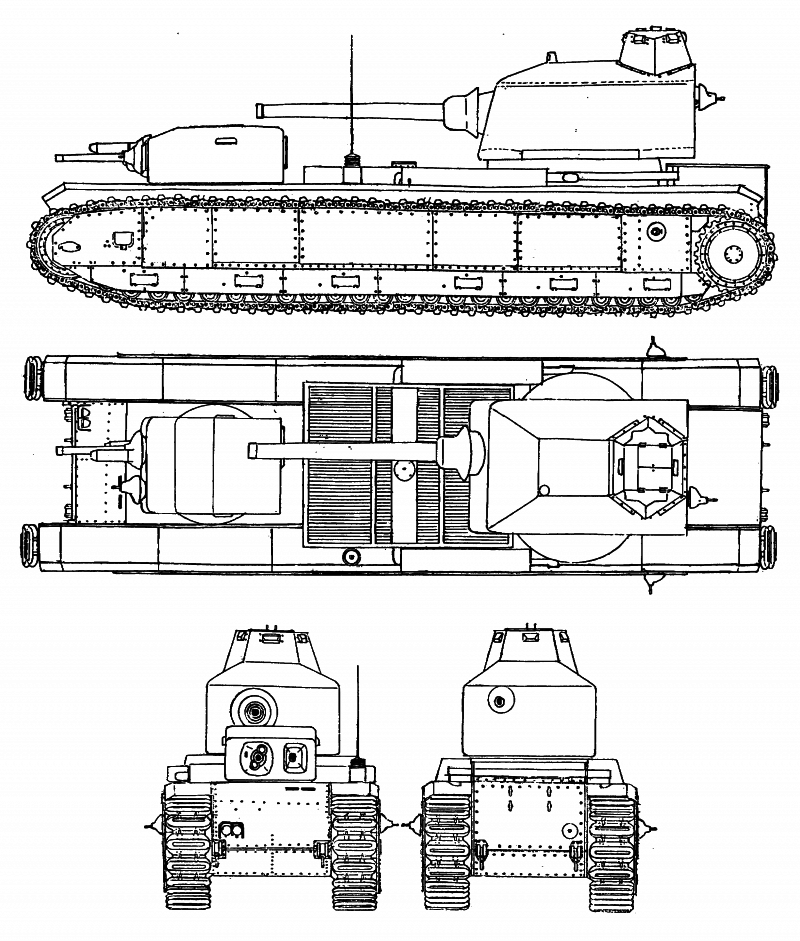
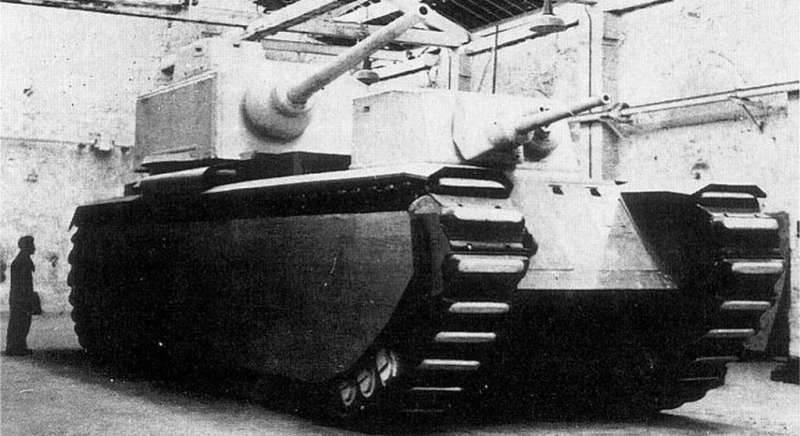
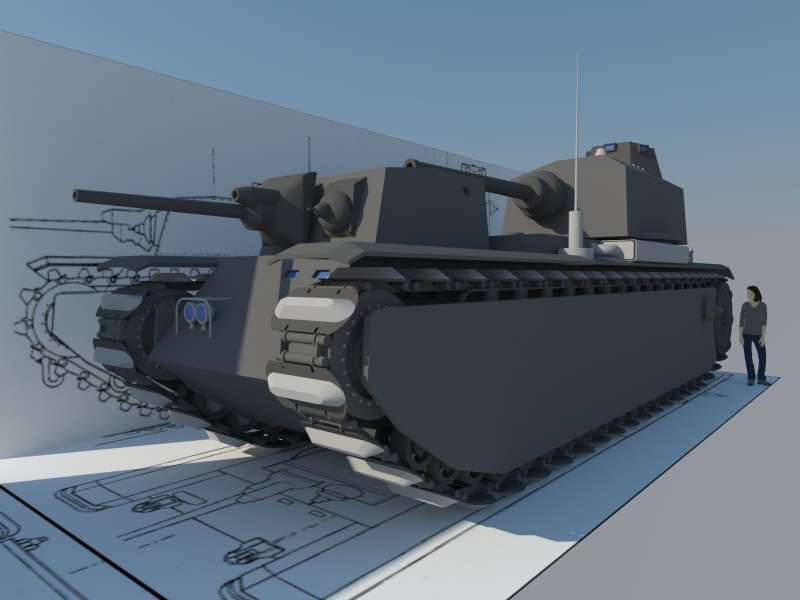
Information